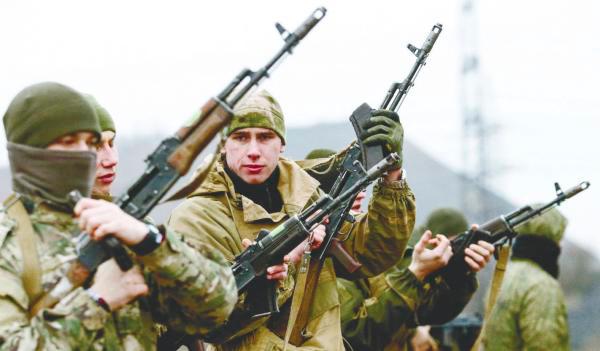NO country in modern history has been subject to the combination of military and non-military action which Russia is experiencing in Ukraine, Europe and elsewhere in the world where various forms of pressure and sanctions have been applied to ensure a Russian military defeat and political capitulation .
A first meeting of 41 countries on April 26, 2022, against Russia has since been enlarged to a larger coalition of 54 countries (all 30 member states of Nato (North Atlantic Treaty Organization) and 24 other countries) at a meeting of countries contributing to Ukraine’s war against Russia held on Feb 14, 2023.
All European Union member states, except for Hungary, Cyprus and Malta, have provided military aid individually and collectively.
However, this is far from being just a European war. The country that has emerged as the most pro-Ukraine and anti-Russia in the coalition is the US. As the war enters its third year, it is crystal clear that peace in Ukraine can only come if the US wants it.
And, this may require Donald Trump presidency to bring Volodymyr Zelensky and Vladimir Putin together for a peace agreement.
For now, the Joe Biden administration has provided more than US$44 billion (RM205 billion) in military assistance for Ukraine since the war started. This is more than the next four European countries’ largest contributors combined – Germany, Britain, Norway and Denmark.
At the last count, the US has spent more than US$75 billion to ensure that the Zelensky government is kept alive and continues to fight what many observers increasingly view as a proxy war.
It is a war that is seen to sacrifice the Ukrainian population as it does not have US troops directly engaged as has happened elsewhere in the recent wars that the US has waged.
Biden has repeatedly stated: “We do not seek to have American troops fighting in Russia or fighting against Russia.”
The US president has made it clear to Americans and the rest of the world that keeping US troops out of the war, while at the same time deeply engaged, is the American strategy after learning from previous wars.
Most US analysts agree that there is no way the American public will support the war if US participation leads to casualties returning to America in body bags as happened in Afghanistan recently.
Thus, Biden is counting on Ukrainians to continue to fight the Russians. Hence, extraordinary efforts and sums are being spent by the US to keep the war against Russia going.
US runs the full gamut of financing, training and supplying Ukraine’s military, helping it to target the Russian army, without involving Russian ships and blowing up Russian military installations. That the Ukrainian and Crimean civilian population is collateral damage has not been a deterrent to the US war machine. Ukrainian bodies and suffering do not matter in the conduct of US foreign policy.
Why the US is playing a leading role in this war on a different continent which some critics say the US has no business in intervening or determining its outcome is due to a combination of factors.
The first is that the US has made it after the Cold War against the Soviet Union. The Cold War dominated the global geopolitical battle for over 50 years. It continues today even after the breakup of the Soviet Union as seen in the US-led Nato policies and actions against Russia.
Ukraine has become a new battleground for the US in its desire to maintain global political and military supremacy.
In this war, the US and other Western public have been kept ignorant of the fact that it is the US and Nato broken promises that played a key role in Putin’s decision to act in the Crimea region which triggered the war.
In a speech at the Munich Security Conference in 2007, Putin accused Western powers of reneging on a pledge not to expand Nato eastwards to the boundaries of Russia.
His concern: “What happened to the assurances our Western partners made after the dissolution of the Warsaw Pact?”
Despite Putin’s repeated expressions of concern and warning that Russian legitimate interests and security were encroached upon and eroded, Nato has not stopped expanding.
Since the fall of the Soviet Union, Nato membership has grown from 17 countries in 1990 to 30 today, and now includes countries which were once part of the Soviet-led Warsaw Pact.
In addition to American encouragement of Nato’s anti-Russia policies and expansion to Russia’s borders, the US has also supported “color revolutions” against Moscow’s neighbors, undermined Russia’s historical relationship with its neighbors and refused to negotiate with Moscow over security policies.
The second major reason is that the war is a bonanza for the US armament industry and military contractors. The US Pentagon spent US$13 trillion for its war in Afghanistan, with one-third to one-half of the total estimated to have gone to military contractors.
Five major corporations listed in the US stock exchange – Lockheed Martin, Boeing, General Dynamics, Raytheon and Northrop Grumman – were major beneficiaries in the past and they, and new armament companies, are prospering from the war in Ukraine.
The Pentagon will spend much less in Ukraine today since it has roped in the military and financial support of Nato and other allied countries. However, the US armament industry and US military contractors will continue to be the main beneficiaries of the war windfall.
During the period 2018 to 2022, the US was estimated to be responsible for 40% of the world armament exports. Other national armament and military contractor beneficiaries of the current Ukraine war include those from France, the UK, Spain, Germany, Italy, Israel, Japan and South Korea.
A full list of military aid provided to Ukraine in the last two years is available on Wikipedia. (https://en.wikipedia.org/wiki/List_of_military_aid_to_Ukraine_during_the_Russo-Ukrainian_War)
This post also provides details of the military assistance provided by Japan and South Korea, the two Asian nations supporting US foreign policy.
A third major reason why the US under Biden wants the Ukraine war to continue is that it sees the war as necessary to cripple the Russo-Sino alliance.
On Oct 12, 2023, a bipartisan US Congress panel maintained that Washington must prepare for possible simultaneous wars with Moscow and Beijing by expanding its conventional forces, strengthening alliances and enhancing its weapons modernization program.
The continuation of the Ukraine war and the eventual defeat of Russia can mean that China, described by Biden as US’s foremost enemy, will be without a key strategic partner in its fight against US policy to take down China.
This assumption is subverted if Russia remains undefeated. For now, the opposite has happened as it has strengthened the Russo-Sino alliance to an unprecedented level of solidarity.
On the other hand, a Trump victory in November can well see the US embark on an exercise to repair relations with Putin and Russia.
Should this happen, it may finally produce the elusive peace that Ukrainians and Russians badly need.
Lim Teck Ghee’s Another Take is aimed at demystifying social orthodoxy.
Comments: letters@thesundaily.com










